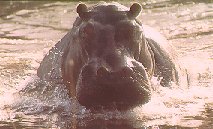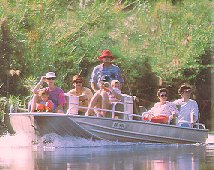


As one of the sectors with the potential to support Botswana's
diversification strategy, the tourism industry has yet to realise
its full potential. since independence Botswana has pursued a
policy of protecting and utilising its wildlife resources for
the benefit of the country and its population. In this corner
of the continent where the vision remains unspoiled, where the
immensity, variety and untamed vitality of the old Africa await,
the ultimate African experience can still be enjoyed.

Rightly renowned for its abundance of game and birdlife as well
as a great diversity of plants, insects and reptiles, Botswana
boasts many national parks and game reserves with a great variety
of habitats, from Kalahari sands to lakes, forests, scrub and
salt pans. Places of interest that offer contrast and new experiences
for the traveller include the Okavango Delta ( a unique geographical
feature and water wonderland), the majesty and mystery of the
Kalahari, the extraordinary landscape of the pan complexes, the
Tsodilo Hills ( a site of ancient artistry) and other legacies
of archaeological sites.
A campfire at sunset on the banks of the Okavango River.
OBJECTIVES
Wildlife utilisation schemes, with the policy of local community participation in the management of wildlife resources, are encouraged with a view to providing employment opportunities in rural areas. Streamlining of the licensing, grading and inspection procedures within the tourism industry is taking place, the government's objective being the creation of an enabling environment for local and foreign investors to undertake business within a free enterprise system.
National parks and game reserves occupy 17 percent of the total area of Botswana, with 20 percent set aside as wildlife management areas. The specific objectives of the Department of Wildlife and National Parks include the following :

A banded mongoose standing on a fallen tree. ->
ENVIRONMENTAL CONSERVATION
In its policies for conservancy and tourism the government of Botswana aims at ensuring that tourism is pursued on an ecologically sustainable basis. Scientific data is collected and collated, analysed and interpreted, in such a way that it can be put into practice in managing and utilising wildlife resources.
Several organisations and societies exist which are dedicated to the conservation of Botswana's environment. Many of these aim to promote knowledge of wildlife resources through education and publicity, to encourage and finance research and to support policies aimed at conservation of wildlife and the many varied habitats.
Attempts to increase public awareness include publications and radio broadcasts, and organisation of symposia and workshops on topics of national importance as well as lectures and field trips. A promotional video on Botswana has also been produced which highlights the main tourist attractions.
Included in these concerned groups are the "Conservation
Education and Public Relations Division, an educational section
of the national museum, an association of wildlife clubs ( which
is primarily a youth movement in institutions of learning) and
the Kalahari Conservation Society. The Botswana Bird Club is
a branch of the Botswana Society which is dedicated to all fields
of knowledge about Botswana, while a forestry association was
started by a group of individuals concerned about the firewood
and fence pole shortages in some parts of the country and the
consequent environmental damage due to over cutting.

SPECIAL ATTRACTIONS
The unique environment of the vast, semi-arid KALAHARI fascinating adaptations have been made by its human, animal and plant populations, with the amazing great pans playing a critically important role in their survival. Distinctly characteristic, too, are the windblown sand dunes, silent and evasive witnesses of the Kalahari's antiquity. Preserving this unique ecosystem are the Mabuasehube Game Reserve and the Kalahari Gemsbok National Park (sharing a common border with the Gemsbok National Park), while the Central Kalahari Game Reserve ( 52 000 square kilometres in extent) was created for the preservation of the Bushman or San, and the Khutse Game Reserve attracts many local visitors - both of these are popular birding spots. In the western part of the country spectacular acacia woodlands are further evidence of the varied vegetation of the Kalahari.
A lion with a zebra kill.
The OKAVANGO DELTA, covering an area of some 16 000 square kilometres, is a wonderland of clear, reed-fringed waterways, lily-spangled pools and unnumbered islands of varying sizes. In addition to marsh, river and open grassland areas the delta, relatively unspoilt by man, has shady riverine forests of palms and towering trees. In few other places in the world are so many varieties of wild creatures to be found in such proximity. A fishermen's paradise, the delta is also renowned for its birdlife, with more than 350 species having been found. Adjacent to the delta, the beautiful Moremi Game Reserve offers excellent game viewing opportunities.
The remote and mysterious TSODILO HILLS are the site of an amazing and prolific collection of prehistoric art - most of the paintings are on exposed faces and within fairly easy distance of each other. DROTSKY'S CAVES are another important attraction, unspoilt and undeveloped, with great winding passages and glistening white flowstone.
The extraordinary features of the scenically stunning MAKGADIKGADI
PAN COMPLEXES have enormous potential for commercial use by the
tourist industry - at Sowa, Nxai and Ntwetwe. The visitor is assured
of viewing game and countless birds - at the Makgadikgadi Pans
Game Reserve, a vast area of unspoilt wilderness, Nxai Pan National
Park and Nata Nature Sanctuary - while other exhilarating activities
could be developed to make the area even more viable as a tourist
destination for sports enthusiasts. On the edge of the small
Kudiakam Pan a striking group of trees known as Baines Baobabs
may be found, while Kubu Island, in the corner of Sowa Pan, has
a magic all its own.

A hippopotamus charging through the waters of the Kwai River. ->
CHOBE NATIONAL PARK, covering a wide variety of country, offers game drives along river roads, with excellent wildlife and bird viewing.
Situated in the strikingly rugged area known as the TULI BLOCK (where archaeological sites have revealed stone tools dating from the early stone age), are the remarkable Solomon's Wall and the Mashatu Game Reserve, devoted to conservation.
ARTS AND CRAFTS
As an integral part of the agricultural tradition in Botswana, baskets have been made for thousands of years. Today their usefulness is valued in any modern home as containers for numerous articles, while the finest examples are considered true works of art. In Botswana baskets with lids are used for storing grain, seeds and occasionally sorghum beer, while open, bowl-shaped baskets are used by the women to carry items on their heads as well as for other general purposes.
From the karakul wool of sheep from south-western Botswana and South Africa, many woven items are made - several co-operative production groups in Odi and Lobatse create woven tapestries, rugs, tablecloths and bedspreads.
Throughout Botswana decorative and utilitarian items are fashioned from wood. Simple hand tools are used to carve out human and animal figurines, while hand-turned or bicycle-run lathes are utilised to produce candlesticks, ashtrays, sugar pots, bangles and rings. Contemporary versions of the traditional kgotla chair, using only wooden pieces, are intricately carved and bolted together.
A variety of clothing fashions, tablecloths, floral curtains and lengths of fabric are produced using silkscreen methods with both reactive and pigment dyes. Jewellery and art objects are made from sterling silver and Botswana gemstones using designs inspired by Bushman rock paintings and wildlife observation. Ostrich eggshell and calabash pieces are used to create earrings and brooches.
In the distant past bone was utilised for pipes, scrapers and arrowheads, and today the art of bone carving has once again been encouraged through the efforts of the rural Industries promotions. A readily available resource is now being used to create intricate figurines and jewellery.
The National Museum and Art Gallery in Gaborone serves as a repository
for art - traditional and contemporary, local and international.
frequent exhibitions include the work of weavers, painters, potters,
sculptors and photographers.

Tourists on a boat safari on the Okavango River.
FACILITIES AVAILABLE
A wide range of tours and safaris is available in most of the parks and reserves to cater for interests such as birdwatching, fishing, photography and hunting. Expert guides with an extensive knowledge of the flora and fauna may be supplied on request. Tourist centres are able to organise safaris in comfortable game-viewing vehicles, for sundowner cruises and boat trips. professional hunting companies offer safaris to hunting enthusiasts, and flight in light aircraft to the carious camps provide splendid opportunities for those who shoot with cameras, a feature in the Okavango Delta is the traditional form of transport, the Mokoro, or dugout canoe, which makes for a memorable experience.
Accommodation is very much a matter of choice and pocket - hotels, lodges, standard safari accommodation in large tents - from the luxurious to the self-contained.
 More SAFARI places to visit...
More SAFARI places to visit...
 go back
go back